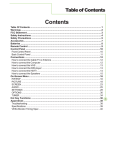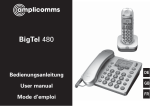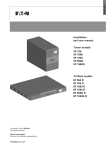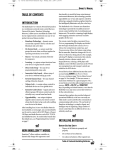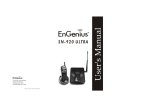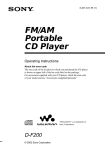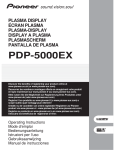Download Vivid Red Projector User manual
Transcript
USER MANUAL Table of Contents 1. INTRODUCTION 2. INSTALLATION & SETUP 3. OPERATION 1.1 The Projector..............................................................2 1.2 Components...............................................................3 2.1 Setting Up Your Projector.............................................4 2.2 Screen And Projection Distance................................... 4 2.3 Power Connection.......................................................5 2.4 External Connection....................................................6 2.4.1 Connecting to a Personal Computer................... 6 2.4.2 Connecting to a Video/ Laser Disk/ DVD Player... 8 2.4.3 Connecting to External Speakers.......................10 2.5 Mouse Functions.........................................................11 3.1 Projector Basics..........................................................12 3.2 Turning On & Turning Off The Projector......................... 15 3.3 Basic Operation.......................................................... 16 3.4 Remote Control Features.............................................19 3.5 Using The Menu..........................................................20 3.5.1 Adjusting the Image......................................... 21 3.5.2 Adjusting Advanced Control.............................. 22 3.5.3 Selecting the Options....................................... 23 3.5.4 Setting the Utilities........................................... 24 3.5.5 Setting the Audio..............................................25 3.5.6 Selecting the Source.........................................25 3.5.7 Selecting the Video Standard............................ 25 4.1 Warnings and Guidelines............................................. 26 4.2 Cleaning.................................................................... 29 4.3 Replacing the Lamp ....................................................29 4.4 Replacing the Air Filter.................. .............................. 30 5. TROUBLESHOOTING 5.1 Common Problems & Solutions ..................... ...............31 6. SPECIFICATION 6.1 Specifications............................................ .................32 7. APPENDICES 7.1 Glossary.....................................................................33 7.2 Menu Tree.................................................................. 34 7.3 Throw Distance...........................................................35 7.4 Serial Communication Cable........................................36 4. MAINTENANCE & CARE Important Information Precautions Please read this manual carefully before using your Vivid Red projector and keep this user manual for your future reference. Labels & Markings This symbol warns the user that the presence of uninsulated voltage within the unit may be sufficient to constitute the risk of electric shock. Therefore, it's dangerous to make any kind of contact with any part inside of the projector. This symbol alerts the user that important operation and maintenance instructions have been provided. This information should be read carefully to avoid problems. Notice This device complies with Part 15 of the FCC Rules. Operation is subject to the following two conditions: 1.This device may not cause harmful interference, and 2.This device must be accepted any interference received, including interference that may causes undesired operation. This Class B digital apparatus meets all requirements of the Canadian Interference-Causing Equipment Regulations. Cet appareil numerique de la classe B respecte toutes les exigences du reglement sur le materiel brouilleur du Canada. WARNING To prevent the risk of fire and shock, never expose the unit to rain or moisture. WARNING Never stare into the beam of light. The extremely high brightness of this projector may cause permanent eye damages. Be especially careful that children do not stare directly into the light. 1 1. Introduction 1.1 The Projector The product is a high brightness, high-resolution video / data projector. It has the following key features: · 3-chip 0.9" D-ILA light engine · 1365 x 1024 native panel resolution (SXGA) · Input pixel formats from 640 x 480 (VGA) up to 1600 x 1200 (UXGA) · Maximum dot (pixel) clock of 162 MHz. · 8-bit digital processing High quality scaling of input pixel format · Input horizontal frequency range 15 - 100 kHz · Input vertical frequency range 50 -100 Hz · Designed to provide a typical light output of 1100 ANSI lumens · Contrast ratio (Full white/black): typical 500:1 in full field · Lamp life of 1500 hours typical · Designed for 100V to 240V (nominal) AC operation from a standard 15 amp wall plug · Lens mount has manually adjustable zoom, focus, 100% offset which is fixed. · 30 to 300 inches diagonal image size · Standard RGB/YUV input with 5 BNCs · Multi-standard video decoder with composite and S video inputs · Accepts and displays all currently known HDTV formats (480i, 480p, 720p) via RGB connection. · Inverse telecine de-interlacing of film-originated video material generated with 3:2 pull-down · Stereo audio inputs & output with control of volume and 2 x 2W speakers · Auto setup feature · Digital keystone feature · Intuitive graphical user interface · Built-in keypad (power, source, menu, up, down, left, right arrows) · Front and rear infrared sensors for IR keypad · Built-in RS232 port · Carrying handle · Built-in mouse port for trackball mouse on remote control · Security feature Kensington Lock · Aspect ratio: standard 4:3 and wide screen 16:9. 2 Introduction 1.2 Components Vivid Red Projector x 1 Laser pointer remote control x 1 Power cable x 1 DATA VOL+ - Mouse connection cable x 1 RGB cable x 1 S-Video cable x 1 User's manual x 1 3 AAA batteries x 2 AV cable x 1 Warranty card x 1 Audio cable x 1 MAC connector x 1 Dual male RCA to female adapter x 1 2. Installation & Setup 2.1 Setting Up Your Projector There are three ways to set the projector: front projection, overhead projection, and rear projection. 1.Determine the image size. 2.Set up a screen or select a non-glossy white wall onto which you can project your image. Adjustment Adjust the height of the projector using the 2 adjusters on the front. Lift the front of the projector while pressing the adjustment levers on the front side of the projector. ! Release the adjustment levers to fix the adjusters in position when the desired angle is reached. ! For fine-tuning, turn the adjusters. 300" 2.2 Screen And Projection Distance 100" 40" ~12 - 16m ~4 - 5.3m 30" ~1.2 - 1.6m ~1.6 - 2.1m Projection distance (L) Screen top Screen bottom Projection distance (L) Screen Size (inch) 30 40 60 80 100 150 200 250 300 (cm) 76 102 152 203 254 381 508 635 762 Screen Size Height (inch) 18 24 36 48 60 90 120 150 180 (cm) 46 61 91 122 152 229 305 381 457 Projection Distance (L) Width (inch) 24 32 48 64 80 120 160 200 240 (cm) 61 81 122 163 203 305 406 508 610 (ft) 3.9- 5.12 5.12- 6.9 7.9-10.5 10.5-14.1 13.1-17.4 19.7-26.2 26.2-35.1 32.8-43.6 39.3-52.5 (m) 1.2 - 1.6 1.6 - 2.1 2.4 - 3.2 3.2 - 4.3 4 - 5.3 6-8 8 - 10.7 10 - 13.3 12 - 16 4 Installation & Setup Ceiling Mount ! If the projector is mounted on the ceiling and the image is upside down, use the Menu and Up, Down, Left, Right button on your projector keypad or on the remote control to correct the orientation. ! The ventilation space shall be 20 cm from the projector foot to the ceiling. Ventilation space Screen top Screen bottom Projection distance(L) WA R N I N G ! Installing the projector on the ceiling must be done by a qualified technician, do not attempt to install the projector yourself. ! Only use the projector on a level, solid surface. If the projector falls to the ground, the user may be injured and the projector severely damaged. ! Do not expose the projector in the moisture, dust, or smoke. This will harm the projected images. ! Make sure there is adequate ventilation around the projector. Do not cover the vents on the side, front or bottom of the projector. ! Do not use the projector where the temperatures vary greatly. The 0 projector must be used at temperatures between 32 F (0 C) and 95 F 0 (35 C). 2.3 Power Connection Plug the projector's power cord into the input socket located on the right side of the projector, plug the three-pronged end of the power cord into a grounded AC outlet. CAUTIONS When the projector is turned off, the fan will continue to run for approximately 12 0 seconds to ensure that the projector and the lamp is cooled down. To avoid thermal stress to the lamp, do not unplug the power cord while the cooling fan is running. 5 Installation & Setup 2.4 External Connection The rear panel of the projector provides the variety of inputs. The projector can be connected to a computer, video, DVD player, laser disc player, etc. 2.4.1 Connecting to The projector can connect to a computer capable of VGA, SVGA, XGA, SXGA and UXGA output. a Personal Turn off the projector and computer before making any connections or Computer disconnections. Connecting a PC ! Use the supplied cable to connect your PC to the projector. ! Turn on the projector and the computer. COMPUTER DVI V.SYNC. H/C.SYNC. B/B-Y PC AUDIO AUDIO OUT MOUSE To DIGITAL RGB terminal (can be used when the PC has a DVI-D terminal) DIGITAL RGB cable (optional) To DIGITAL RGB output terminal ( DVI-D terminal) L- AUDIO -R RS232C To AUDIO terminal (sound can be produced) Stereo audio cable (supplied) To sound output terminal G-Y R/R-Y VIDEO S-VIDEO To 5-plug BNC terminal (used when using 5-plug BNC input to prevent loss of image quality) 5-plug BNC cable (optional) To RGB output terminal To RGB terminal (this connection enables PC images to be projected) RGB cable (supplied) To RGB output terminal NOTE: ! If the computer output is a 5-plug BNC type, use the 5-plug BNC computer cable. ! If the computer has a DVI terminal, use the DVI cable to connect to the DVI port in the projector. 6 Installation & Setup Connecting a Macintosh ! Use the supplied signal cable and Macintosh adapter to connect your Macintosh computer to the projector. ! Turn on the projector and the Macintosh computer. DVI V.SYNC. H/C.SYNC. PC AUDIO AUDIO OUT MOUSE To DIGITAL RGB terminal (can be used when the PC has a DVI-D terminal) DIGITAL RGB cable (optional) To DIGITAL RGB output terminal ( DVI-D terminal) To AUDIO terminal (sound can be produced) COMPUTER G-Y B/B-Y L- AUDIO -R RS232C R/R-Y VIDEO S-VIDEO To 5-plug BNC terminal (used when using 5-plug BNC input to prevent loss of image quality) Stereo audio cable (supplied) To RGB terminal (this connection enables PC images to be projected) 5-plug BNC cable (optional) To RGB output terminal To sound output terminal MAC connector (supplied) RGB cable (supplied) To RGB output terminal MAC connector (supplied) When using a MAC connector, set the dip switches as follows. Mac 13" Mode (640 x 480) Switches 1, 5, 6 ON Mac 16" Mode (832 x 624) Switches 2, 5, 6 ON Mac 19" Mode (1024 x 768) Switches 3, 5 ,6 ON Mac 21" Mode (1152 x 870) Switches 1, 2, 3, 5, 6 ON NOTE: ! Use the Macintosh adapter to connect a Macintosh computer to the projector, otherwise it may result in a blank screen. ! Remove the small cover on the Macintosh adapter. Set the DIP switches in accordance with the resolution you want to use. ! When connecting to a Macintosh notebook, a special adapter (commercially available) may be necessary in addition to the Macintosh adapter. See Macintosh notebook manual for additional information on connecting a computer cable. 7 Installation & Setup 2.4.2 Connecting to a Video/ Laser Disk/ DVD Player A VCR, a laser disc player, DVD player, or any other compatible video image source can connect to the projector. Turn off the projector and video source before making any connections or disconnections. The projector can receive composite video, S-Video, or component video. Connecting a Composite Video Source: ! If the video source uses a RCA connector, you will need the RCA cable to connect to the projector. Connect the yellow RCA plug on one end of RCA cable to the projector's video jack, and connect the other end of the yellow RCA plug to your video source. Connecting a S-Video source: ! If the video source uses S-Video connector, connect one end of the S- Video cable into the S-Video connector of the projector, the other end to the S-Video-out jack of your video source. Connecting a Component Source: ! Insert three ends of a BNC cable into the projector's B/B-Y, G-Y, R/R-Y jacks. Insert the other ends of the cable into the B/B-Y, G-Y, and R/R-Y jacks on your component video source. (Don't insert any of the cable ends into the H-Sync and V-Sync jacks.) Connecting an Audio Source: ! Connect the RCA audio cable to the Audio jacks of the projector: insert the white plug into L and the red plug into R jack. Connect the other end of RCA audio cable to your video source. 8 Installation & Setup Connecting to a Video / Laser Disk / DVD Player DVI V.SYNC. COMPUTER H/C.SYNC. B/B-Y L- AUDIO -R PC AUDIO AUDIO OUT MOUSE To B/B-Y, G-Y, R/R-Y terminal (used to connect equipment with component output terminal) RCA-BNC cable(optional) To B/B-Y, G-Y, R/R-Y terminal (on equipment with component output terminal) Laser disk player 9 To AUDIO terminal (Sound can be produced) G-Y RS232C R/R-Y VIDEO S-VIDEO To S-VIDEO terminal (used to connect equipment with S-Video output terminal) Stereo audio cable(supplied) To audio output terminal Video deck To VIDEO & AUDIO L/R terminal (this connection enables image and sound output) S-Video terminal cable (supplied) To S-Video output terminal AV cable (supplied) To video/audio output terminal DVD player Installation & Setup 2.4.3 Connecting to An external speaker system can connect to the projector to gain maximum benefit from the projector's built-in sound function. External Turn off the projector and speaker system if they are on. Speakers ! Connecting the stereo audio cable's miniplug to the projector's Audio Out jack. ! Connecting the other end of the stereo audio cable to the dual male RCA to female adapter. ! Connecting the RCA plugs to the external speakers. Insert the cable's red plug into the Audio R jack, and the white plug into the Audio L jack. NOTE: The internal speakers are disabled when an external sound system is used. DVI V.SYNC. COMPUTER H/C.SYNC. PC AUDIO AUDIO OUT MOUSE B/B-Y G-Y L- AUDIO -R RS232C R/R-Y VIDEO S-VIDEO To Audio Out terminal Stereo audio cable(supplied) 10 Installation & Setup 2.5 Mouse Functions The remote control can be used as a wireless mouse by connecting the projector mouse port to the computer mouse port. Connecting the Mouse: ! Connecting the big end of the PS/2 mouse cable (9 pin) to the projector mouse port. ! Connecting the small end of the PS/2 mouse cable (6 pin) to the computer's mouse port. ! For a Macintosh computer, connect the USB mouse or PS/2 mouse. DVI V.SYNC. H/C.SYNC. PC AUDIO AUDIO OUT MOUSE COMPUTER G-Y B/B-Y L- AUDIO -R R/R-Y VIDEO S-VIDEO RS232C To Mouse PS/2 terminal To Mouse (PS/2) terminal Mouse cable (supplied) To Mouse (USB) terminal How to Use the Remote Control as a Wireless Mouse: ! Right Mouse button ! POWER MENU LASER KEYSTONE ZOOM DATA Mouse pointer button ! AUTO FREEZE VIDEO ! LM Left Mouse button 11 RM UP LEFT DOWN VOL+ VOL - RIGHT Right Mouse button ! The right mouse button is marked RM on the right of the remote control. Left Mouse button The left mouse button is marked LM on the left of the remote control. Moving the Cursor Use the mouse pointer button to move the cursor left, right, up, down. Select Item Move the cursor to item and press the LM button. Drag While pressing the LM button, press the mouse pointer button to drag in the desired direction. 3.Operation 3.1 Projector Basics Front/ Side Features Control keypad Zoom lever Lens Remote sensor Speaker Handle Main power switch AC input Ventilation Height adjuster Adjustment levers Focus ring Height adjuster Rear/ Side Features Security Lock * Adjustment levers Height adjuster I/O terminal panel Speaker Remote sensor Security Lock Note: The projector can connect to a commercially available security cable (Kensington's). 12 Operation Bottom Features Rear foot Air filter (small) Air filter (large) Lamp cover Lamp cover screw Control Keypad Features LAMP WE R PO 1 1. Lamp Indicator 2 2. Power Button & Power Indicator Use this button to turn the power on and off when the main power switch on the side of the projector is switched on and the projector is in standby mode. SOURCE 3 MENU 4 5 3. Source Button Use the button to select a proper source such as PC, VCR, DVD player, etc. 4. Menu Button Displays the menu. 5. Up, Down, Left, Right Button Use Up, Down to select the menu item you wish to adjust. Use Left, Right button to change the level of selected menu item. 13 Operation I/O Terminal Features DVI COMPUTER G-Y R/R-Y L- AUDIO -R VIDEO V.SYNC. H/C.SYNC. B/B-Y PC AUDIO AUDIO OUT MOUSE RS232C S-VIDEO 14 Operation 3.2 Turning On & Turning Off The Projector Before turning on the projector, make sure the video source is turned on and the lens cap is removed. Connect the power cord to the projector. Turning On the Projector: 1. Turn on the main power switch on the side of the projector, the projector will go into its standby mode and the power indicator will glow orange. 2. Press the Power button on the projector control keypad or on the remote control, the power and lamp indicator will glow green and the projector will be ready to use. Turning Off the Projector: LAMP P OWE R 1. Press the Power button on the projector control keypad or on the remote control, the message as below will show on screen. Press the Left button to move the cursor to "Power Off" and press Menu button to turn off the projector, and the power indicator will glow orange. After the projector is turned off, the cooling fan will continue to run for 120 seconds and then stop. SOURCE MENU POWER BUTTON WAS PUSHED! Move the cursor to "Power Off" and press MENU button to turn projector off. Power Off POWER MENU KEYSTONE ZOOM DATA AUTO FREEZE VIDEO LM RM UP LEFT DOWN Cancel LASER VOL+ VOL- RIGHT NOTE: Do not disconnect the power cord or switch off the main power switch when the cooling fan is still running. NOTE: If mis-press the Power button, move the cursor to "Cancel" by pressing the Right button and press Menu button to resume. The message will disappear after 10 seconds if there is no response. 2. Switch off the main power switch on the side of the projector and unplug the power cord. The power indicator will go out. Power and Lamp Status Indicators Messages Chart: Condition Power Indicator Lamp Indicator Main power switch on Orange (side) Power On Green Green Power Standby Orange Cooling down Flashing green Lamp life (1500 hrs) Green Flashing Green 15 Description Flashing for 120 seconds Lamp timer, message of "The lamp is reaching its limit. Please replace the lamp as soon as possible." appears on screen when the lamp reaches 1400 hours usage ; "Lamp Expired" When lamp reaches 1500 hours usage. System error Orange Flashing Red (1 sec interval) Projector in power standby mode and cannot be turned on Temperature error Orange Flashing Red (2 sec interval) Projector in power standby mode and cannot be turned on Lamp error Orange Fan error Orange Flashing Red (4 secs interval) Flashing Red (8 secs interval) Projector in power standby mode and cannot be turned on Projector in power standby mode and cannot be turned on Operation 3.3 Basic Operation Adjusting the Tilt Feet 1. Lift the front edge of the projector. 2. Press the adjustment levers on the front of the projector and hold the levers. 3. Lower the front of the projector to desired height and release the lever to lock the tilt feet. 4. Fine-adjust the height, use the height adjusters on the front of the projector. 1 2 4 3 2 Loading the Batteries (2 size AAA betteries) 1. Open the battery compartment cover on the back of the remote control unit in the direction shown. 2. Insert two size AAA batteries, ensure that the positive and negative terminals are aligned correctly. 3. Close the battery cover in the direction shown. Batteries Note: ! Replace the battery as soon as they run out. ! Remove the batteries if the remote control unit is not used for a long period of time. ! Dispose the used batteries in accordance with local recycling and waste disposal ordinances. ! When changing the batteries, use two new batteries of the same type. 16 Operation Selecting the Desired Image Press the Video button on the remote control to cycle through the video inputs.(Composite, S-Video, Component) Press the Data button on the remote control to cycle through the RGB graphics inputs. (RGB, Component, DVI) Press the Source button on the control keypad to start source auto scan through composite Video, S-Video, component video (if connecting BNC with video source), Analog RGB, component RGB (if connecting BNC with computer source), and DVI. LAMP Source button WE R PO Data button SOURCE Video button POWER MENU LASER KEYSTONE ZOOM DATA AUTO FREEZE VIDEO MENU LM RM UP LEFT DOWN Adjusting the Focus Use the focus ring to obtain the best focus. Adjusting the Zoom of the Image Use the Zoom lever to adjust the image size on the screen. Use Keystone correction to keep the image square. Zoom lever Focus ring 17 VOL+ VOL- RIGHT Operation 1 POWER MENU Zoom button KEYSTONE ZOOM AUTO DATA FREEZE LM RM UP LEFT DOWN VOL+ VOL- RIGHT 1. Press the Zoom button on the remote control. 2. Use Vol+ button to enlarge the Image, Volbutton to return the enlarged image to its original size. The zoom ratio can be 10 times the original image size. LASER VIDEO Adjusting Digital Zoom of the Image 2 Vol+ / Vol- LAMP WE R PO LASER KEYSTONE ZOOM MENU AUTO DATA SOURCE FREEZE VIDEO 3. Move the image to the area you wish to see by using the Up/ Down, Left/ Right buttons on the remote control. 4. Press zoom button again to cancel the enlargement and return to the normal status. POWER MENU LM RM UP LEFT DOWN 3 VOL+ VOL- RIGHT Up, Down, Right, Left buttons Correcting the Keystone Distortion Press the keystone button, And adjustment scale is displayed. POWER MENU Keystone button LASER KEYSTONE ZOOM DATA AUTO FREEZE VIDEO LM RM UP LEFT DOWN VOL+ VOL- RIGHT Press Vol+ button to adjust the upper part of the image; Use Vol- button to correct the lower part of the image. Adjusting the Volume Press the Vol+/ Vol- buttons on the remote control to increase or decrease the volume. 18 Operation 3.4 Remote Control Features 1 1. Infrared Transmitter 2. Laser Pointer 3. LASER KEYSTONE ZOOM DATA AUTO FREEZE VIDEO 13 Front POWER MENU 5 8 7 6 LM RM UP 15 17 LEFT DOWN VOL+ VOL- RIGHT 3 4 9 10 11 12 14 16 18 2 Direct the remote control to the remote sensor on the projector. Beams a laser light when "Laser" button is pressed. Power Button 9. Zoom Button Press this button and a zoom ratio scale pops up. Use "Vol+", "Vol-" button to select the zoom ratio, "Up", "Down", "Left", "Right" buttons to move the center of the image. 10. Auto Button Press this button to auto adjust the image. While the power is applied, main power switch on the side of the projector is switched on, use this button to turn on/ off your projector. 11. Freeze Button 4. Laser Button Press and hold this button to activate the laser pointer. 1 2. Mouse Pointer Button When you are in computer mode, this button works as a computer mouse. 5. Menu Button 13. Left Mouse (LM) Button 6. Video Button 7. 8. (1) Displays the menu for various adjustment. (2) Return to the sub-menu. (3) Exit from the menu Press this button to select a proper video source. The video sources sequence is: Composite video, S-Video, and Component video. Data Button Use the button to select a proper data source. The data sources sequence is Analog RGB, component RGB, and DVI. Keystone Button Press the keystone button and a keystone scale shows up in the screen, press "Vol+", "Vol-" buttons to correct the keystone distortion, and make the image square. 19 This button will freeze a picture. Press again to resume motion. This button corresponds to the left mouse click when in computer mode. 14. Right Mouse (RM) Button This button works as the right mouse click when in computer mode. 15. Left Button Adjust the value in the sub-menu. 1 6. Right Button (1) Adjust the value in the sub-menu. (2) Move to the sub-menu. 17. Up/Down Button Select the menu of the item you wish to adjust. 18. Volume up/Volume down (Vol+/Vol-) Button Adjust the volume scale when menu is not displayed. Operation Range of Use of the Wireless Remote Control Within 10 m (11 yards) Within 10 m (11 yards) 3.5 Using The Menu RM RIGHT VOL+ VOL- DOWN UP LM LEFT AUTO LASER FREEZE VIDEO POWER KEYSTONE ZOOM DATA 15 MANU MENU W ER LAMP PO SOURCE FREEZE AUTO LASER RM RIGHT VOL+ VOL- POWER DOWN UP KEYSTONE ZOOM MANU DATA VIDEO LM LEFT 15 1. Press Menu button. The menu screen is displayed. Example : When RGB is selected for the input source. 2. Select the menu item you wish to adjust with Up /Down buttons on the remote control or on the control keypad 3. Press the Right button to go into the sub-menu 4. Use Left / Right button to adjust the sub-menu scale. 5. Press Menu again to go back to the previous level. 20 Operation 3.5.1 Adjusting the Image RGB Image Menu ! Brightness Video Image Menu Adjust the brightness of the picture. Press Left button to make it darker, Right button to make it brighter. ! Contrast Adjust the image contrast by pressing Left button to make it weaker, Right button to make the contrast stronger. ! H position Adjust the picture horizontal position by pressing Left and Right buttons. ! V position Adjust the picture vertical position by pressing Left and Right buttons. ! Phase (RGB only) Remove the last indications of noise or shaded areas that remain on the screen after completing the adjustment. ! Frequency (RGB only) Control the horizontal size to match the projector to the computer. ! Color (Video only) Adjust the depth of the colors. Press Left button to make it lighter, Right button to make the color deeper. ! Tint (Video only) Adjust the tint by pressing Left button for a greenish tint, Right button for a reddish tint. ! Detail (Video only) Control the detail of the image. Press Left button to make it softer, Right button make the image sharper. 21 Operation 3.5.2 Adjusting Advanced Control RGB Advanced Menu Video Advanced Menu ! Sharpness ! ! ! ! ! Adjust the sharpness level by pressing Left/ Right buttons to choose. User Red Adjust the strength of the red color. Press Left button to make it weaker, Right button to make it stronger. User Green Adjust the strength of the green color. Press Left button to make it weaker, Right button to make it stronger. User Blue Adjust the strength of the blue color. Press Left button to make it weaker, Right button to make it stronger. Scaling (RGB only) Fill Fill the image to the whole projected area. Aspect Enlarge the image while maintaining the original aspect. 1:1 Original input resolution and size. Scaling (Video only) Select the best aspect mode to display your video image. Normal as standard 4:3 aspect. Anamorphic as up and down stretched. Zoom as all 4 sides stretched. Wide as left and right stretched and keep it as 16:9 aspect. 22 Operation 3.5.3 Selecting the Options Options Menu ! OSD ! ! ! ! 23 Choose the OSD position to be in the left/middle/right corner of upper/middle/lower part of the screen. Language Select the languages of menu display: English, German, French, Spanish, and Chinese. BNC Select the source type when connecting the BNC terminal. When the input source is the computer, select RGB. When the input source is the video, select YUV. Image Orientation Select "Inverted" to turn the image upside down when you put the projector on the ceiling. Rear Projection Select "On" to reverse the image when you put the projector behind the translucent screen. Operation 3.5.4 Setting the Utilities Utilities Menu ! OSD Timeout Select how long you wish your OSD will be displaying on the screen. ! OSD Background ! ! ! ! ! Select the OSD background to be opaque or translucent. Freeze Frame Freeze the picture by selecting "On", cancel it by selecting "Off". Keystone Correct the keystone distortion. Press Left/ Right buttons to correct the keystone distortion, and make the image square. The maximum keystone correction is 15 degrees upward and downward with the projector placed horizontally on the ground plane. Zoom Use the zoom scale to enlarge the image or to return the enlarged image to its original size. The zoom ratio can be 10 times the original image size. Move the image to the area you wish to see by using the Up/Down, Left/ Right buttons on the remote control or control keypad. Lamp Life Indicates how many hours the current lamp has been used. Factory Reset Back to the factory default. 24 Operation 3.5.5 Setting the Audio ! Mute Audio Menu Mute the sound by selecting "On", back to normal by selecting "Off". ! Source Select the audio source from video input or RGB input. ! Mode ! ! ! ! Set the audio to be mono or stereo. Volume Adjust the volume by pressing Left button to decrease the volume, Right button to increase the volume. Bass Adjust the power of bass sound. Press Left button to decrease the strength, Right button to increase the strength. Treble Adjust the treble level. Press Left button to decrease the level, Right button to increase the level. Balance Adjust the balance of left and right speaker. Press Left button to increase the left speaker sound, Right button to increase the right speaker sound. 3.5.6 Selecting the Source Source Menu Select the connected source type. When connecting the computer, choose from D-Sub, Component RGB or DVI source. When connecting the video, choose from S-Video, Composite video or Component Video. 3.5.7 Selecting the Video Standard Standard Menu - Video only Select the video broadcasting format. Set on Auto Standard for normal use. 25 4. Maintenance & Care 4.1 Warnings and Guidelines Labels & Markings WARNING Never look directly into the projector lens. The extremely high brightness of the projector can cause permanent eye damage. Observe and follow all warnings and instructions marked on the projector. This symbol warns the user that the presence of uninsulated voltage within the unit may be sufficient to constitute the risk of electric shock. Therefore, it's dangerous to make any kind of contact with any part inside of the projector. This symbol alerts the user that important operation and maintenance instructions have been provided. This information should be read carefully to avoid problems. Protection Location " Operate the projector in an environment which meets the operating range specification in Section 6, Specifications. Do not operate the projector close to water, such as near a swimming pool. " Do not place the projector on an unstable cart, stand or table. If the projector is to be ceiling mounted, only use the Christie-approved ceiling mount fixture. " A projector and cart combination should be used with care. Sudden stops, excessive forces, and uneven surfaces may cause the projector and cart combination to overturn. Lamp and Filter Replacement " Always turn off the power switch before replacing the lamp. Allow the unit to cool off for at least one hour before replacing the lamp. Replacing the lamp according to the directions in the operational manual. Burns or electrical shock may occur if the replacement is performed incorrectly. " Do not tamper with the lamp interlock mechanism. Electrical shock or other damage may occur if the interlock mechanism does not operate correctly. " When the lamp is removed, handle it with care, and ensure it is not subjected to impact. Do not use the lamp unit if it has been subjected to shock or scratched. Contact your sales office for repair. " Do not touch the terminal end of the lamp unit or the screws, which secure the connector. Even if screws become loose, do not attempt to perform the repair operation yourself and contact your sales office. This condition may result in fire, electrical shock or other damage. WARNING If you continue to use the lamp after the lamp expired message has been displayed on the screen, the lamp bulb may shatter and pieces of glass may scatter inside the projector and out into the room. Do not touch glass as it may cause injury. Contact your sales office for lamp replacement. " Replace the air filter every time the lamp is replaced. If this filter is not replaced, air flow may be restricted and cause the projector to overheat. 26 Maintenance & Care Power Cord and Attachments " Only use attachments or accessories recommended by Christie, such as the specific power cord supplied. Use of other attachments or accessories with this projector may result in the risk of fire, shock or personal injury. WARNING Use only the AC power cord supplied. Do not attempt operation if the AC supply and cord are not within the specified voltage and power range.(see section 6) " Do not allow anything to rest on the power cord. Locate the projector where the cord can not be abused by persons walking on it or objects rolling on it. " Operate the projector at the specified voltage only. Do not overload power outlets and extension cords as it can result in fire or shock hazards. " The projector is equipped with a three wire plug having a third (grounding) pin. This is a safety feature. If you are unable to insert the plug into the outlet, contact an electrician to have the outlet replaced. Do not defeat the safety purpose of the grounding-type plug. " Always turn off the power before connecting cables and other connections. Read the instruction manuals of the other equipment connected to the projector thoroughly. Fire or electrical shock may occur when these operations are performed if the main power is turned on. " Do not touch the electrical plug when there is thunder or lighting. Touching the projector in this condition may cause electrical shock. " Do not place the electrical cord near a heater or other objects that generate high temperatures. " Inspect the electrical plug periodically. Fire or electrical shock may occur if the insulation on the electrical plug becomes defective. " Always pull out the electrical plug when the unit is not used for a long period of time. If the plug is not removed, the insulation may deteriorate and cause electrical shock or a fire due to current leakage. " Always grasp the plug firmly and never pull on the electrical cord to remove the electrical plug from the wall outlet. If the cord is pulled, it may be damaged and cause fire or electrical shock. " Never touch the electrical plug with wet hands. 27 Ventilation " " " " " " Servicing " Maintenance & Care Before unplugging the power cord, make sure the internal lamp cooling fans have shut off. The fans automatically shut off when the projector has adequately cooled down. Slots and openings in the projector provide ventilation. To ensure reliable operation of the projector and to prevent overheating, these openings must never be blocked or covered. The projector should never be placed near or over a radiator or heat register. The projector should not be placed in an enclosure unless proper ventilation is provided. Do not place the unit on top of a carpet or cushion. Always place the projector in a well-ventilated area to ensure proper airflow (30 cm or 12 inches away from any wall is recommended) Do not push objects of any kind into the projector through the ventilation openings. They may touch dangerous voltages or short-out components resulting in a fire or shock hazard. Do not spill liquids of any kind into the projector. Should an accidental spill occur, immediately unplug the projector and have it serviced by a qualified service technician. Never place the projector in a location subject to steam, oily smoke, heat or humidity. This may cause fire or electrical shock. Ensure that the projector has warmed up to room temperature before using it. Dew or moisture condensation may be produced inside the projector if there is a temperature difference between the inside and outside of the unit. The condition may cause electrical leakage, shock or fire. If any of the following conditions exist, immediately unplug the projector from the power outlet and refer service to qualified service personnel. - The power cord has been damaged. - The internal cooling fans do not come on when the projector is first turned on. - Liquid has been spilled in the projector - The projector has been exposed to excessive moisture. - The projector does not operate normally. - The projector has been dropped or the case has been damaged . - Projector performance has deteriorated. - There is an abnormal condition (i.e.: smoke coming from projector) ! Do not loosen any screws that are indicated by the arrow mark. The unit contains internal parts, which have high voltage or high temperatures. Touching these parts may cause electrical shock or severe burns. ! Do not attempt to service the projector yourself. All servicing must be performed by a qualified Christie service technician only. If replacement parts are required, it is important that only Christie-approved parts are used. Other parts may result in fire, electric shock or risk of personal injury. 28 Maintenance & Care Other Items " Do not turn on the electricity or the lamp when the lens cap is attached. The lens cap will become deformed due to the heat of the lamp and may cause fire or severe burns. " A laser beam is projected if the laser button in the accessory wireless remote control is pressed. Never look directly into the laser beam. The laser beam may cause damage if it enters the eyes directly. 4.2 Cleaning Cleaning the Case Wipe lightly with a soft, dry cloth. If the case is very dirty, clean the case with a soft, dampened cloth using mild commercial cleaner and finish with a dry cloth. Do not use liquid or aerosol cleaners. Cleaning the Lens To prevent scratching the lens, clean the lens only if absolutely required. Clean the lens with a commercially available blower or cleaning paper gently in a circular motion. Cleaning the Lamp It is important to never touch the glass surface of the lamp, as the oil imprint will seriously degrade lamp performance. If the surface of the lamp is accidentally touched, clean carefully with a lint-free cloth moistened with isopropyl alcohol. 4.3 Replacing the Lamp When the lamp reaches the end of its service life, the image will become darker and colors lose their richness. When the lamp has been operating for 1400 hours or longer, the lamp status LED indicator will flash green, and the message "The lamp is reaching its limits. Please replace the lamp as soon as possible" will be displayed on the screen. Even though the lamp may still be working, replace the lamp to maintain optimal projector performance. When the lamp has been operated for 1500 hours, the message " LAMP EXPIRED!!" will be shown on the screen, replace the lamp immediately. CAUTION DO NOT TOUCH THE LAMP immediately after it has been used. It will be extremely hot. Allow the fan to finish its cooling process, then turn the projector off, and disconnect the power cord. Allow at least one hour for the lamp to cool down before handling. DO NOT REMOVE ANY SCREWS except the lamp cover screw and two lamp housing screws. Removing other screws could result in electric shock to the user. If continuing to use the lamp after the replacing lamp message has been displayed on screen, the lamp bulb may shatter, and pieces of glass may scatter inside the projector and out into the room. Do not touch them as the pieces of glass may cause injury. If this happens, contact your dealer for lamp replacement. 29 Maintenance & Care To Replace the Lamp: 1. Loosen the lamp cover screw and remove the lamp cover. 2. Loosen the two screws securing the lamp housing. Remove the lamp housing by pulling on the handle. 3. Insert a new lamp housing until it is plugged into the socket. 4. Secure it in place with the two screws. 5. Re-attach the lamp cover. 6. Tighten the lamp cover screw. 7. Reset the lamp timer. To Reset the Lamp Timer: 1. Press Left button, Menu button, and Up button within one second on the control keypad or remote control to enter engineering menu as shown: 2. Go to lamp reset sub-menu and move the cursor to Reset option. Press Right button to select. 3. Lamp timer will reset to 0 hour usage. 4.4 Replacing the Air Filter There are two air filter sponges in the bottom of the Vivid Red projector to capture dust or dirt and should be replaced whenever the lamp module is replaced. The temperature will rise and the lamp will fail to light when the air filters inside of the projector become dirty and clogged. Replacement will be required more often if the projector is used in the a particularly dusty environment. 1. Unplug the power cord from the socket. 2. Remove the small filter holder and unscrew the big air filter screw. 3. Detach the air filters. 4. Replace the air filters. 5. Install the air filters. 6. Re-install the filter covers. 30 5. TROUBLESHOOTING 5.1 Common Problems & Solutions Problems Does not turn on Check These Items " Check that the power cable is plugged in and that power switch on the side of projector is switched on, and power button on the projector control keypad or remote control is pressed on. No image " Check that the projector is on. " Use the menu to select the source (Composite video, S-Video, Component video, Analog RGB, Component video or DVI). See page 25. " Ensure the cables are connecting correctly. " Use the menu to adjust the brightness and contrast. See page 21. Or reset the settings to factory preset level using the Factory Reset option on the Utilities menu. See page 24. " Remove the lens cap. Image is blurred " Adjust the focus. See page 17. " Ensure the distance between the projector and the screen is within the focus range of the lens. See page 4. Image is too dark " Adjust the contrast or brightness in the Image menu properly. See page 21. No sound Remote control does not work Status indicator is lit or blinking 31 " Ensure the cables are connecting properly. See page 10. " Make sure the Mute option in Audio menu is selected Off. See page 25. " Install new batteries. See page 16. " Make sure there is no obstacles between you and the projector receivers. " Stand within the distance of remote control usage range. See page 20. " See the Power and lamp indicator message chart on page 15. 6. SPECIFICATION 6.1 Specifications Model Number: Display Technology Resolution Projection Lamp Brightness Brightness Uniformity Contrast Ratio Aspect Ratio Projection Lens (Zoom) Screen Size Throw Distance Keystone Correction Digital Zoom Remote Control Video Compatibility Computer Compatibility H-Sync Range V-Sync Range Dot Clock Sound Output Terminals Inputs Terminals Outputs Voltage Power Consumption Dimensions Weight Approvals Audible Noise Accessories List Vivid Red 0.9" LCOS D-ILA x 3 SXGA (1365 x 1024) 200W UHP lamp, 1500 hours typical 1100 ANSI lumens typical 85% typical 500:1 (full on / full off) typical Standard 4:3 and wide screen 16:9 F=2.5, f=36 - 45mm, zoom ratio1.3, Manual Focus /Manual Zoom 30" - 300" 1.2 - 16m 15 degree 10X Full functionality IR remote with mouse control and laser pointer NTSC / NTSC4.43 / PAL / PAL-M/ PAL-N / PAL 60 / SECAM / HDTV 720p UXGA / SXGA / XGA / SVGA / VGA / MAC 15 - 100 kHz 50 - 100 Hz 162 MHz 2W Stereo x 2 PC Input: D-sub15 pin x 1 Audio Input: RCA x 2 Video Input: RCA x 1 S-Video x 1 Component Input x 1 Digital Computer x 1 (DVI) Mouse port Audio Output: Mini jack x 1 100 - 240 VAC, 50 - 60 Hz universal 380 W (Max) 12.7"(L) x 11.5"(W) x 5.3"(H) 324 mm (L) x 293 mm (W) x 136 mm (H) 5.8 kg (12.8 lbs.) FCC Class B, UL, cUL, CE, TUV 38dB typical User Manual, Laser Pointer remote control, Power/ Computer/ Stereo Audio / S-Video / Composite Video cable, Monitor Adapter for Macintosh (DIP-SW), Dual Male RCA to Female 3.5mm adapter, PS/2 - USB mouse cable 32 7. Appendices 7.1 Glossary This appendix defines the specific terms used in this manual. Aspect ratio Brightness Contrast (ratio) Component Video Composite Video Keystone Lumen NTSC The balance of light and dark shades in an image. The degree of difference between the lightest and darkest areas of the image. A high-end digital(YCrCb) and analog(YPrPb) component video signal. The output of video tape and some computers which combines synchronization, luminance and color signals on one output cable. A distortion of the image which occurs when the top and bottom borders of the image are unequal in length. The unit of measure for the amount of visible light emitted by a light source. A 525-line video format of some video tape and disk players. NTSC is widely used in North America, Mexico and Japan. OSD (On Screen Display) Menu. A list of selectable options displayed on the screen. PAL A 625-line video format used in Western Europe, India, China, Australia, New Zealand and parts of Africa. Pixel Resolution RS-232 The smallest discernible element of data from a computer generated image. A measure of the maximum amount of horizontal and vertical pixels contained in an image. Such as 1280 x 1024 (called SXGA) A common asynchronous data transmission standard recommended by the Electronics Industries Association (EIA). Also called serial communication. S-Video A type of video signal from certain video tape players and video equipments. S-Video transmits luminance and color separately, typically producing a higher quality display than composite video. SECAM A video format of some video tape and disk players, used primarily in France, Eastern Europe, Russia and parts of Africa. SECAM signals are similar in resolution and frequency to PAL signals. Tint Zoom 33 The ratio of the width of an image to its height. Balance of red-to-green necessary for realistic representation of NTSC signals. The adjustment of image size. Appendices 7.2 Menu Tree Image Advanced Options Utilities Audio Source Standard RGB Image Signals Brightness Contrast H Position V Position Phase Frequency Video Image Signals Brightness Contrast H Position V Position Color Tint Detail RGB Image Signals Sharpness User Red User Green User Blue Scaling Fill Aspect 1:1 Video Image Signals Sharpness User Red User Green User Blue Scaling OSD Language BNC Image Orientation Rear Projection OSD Timeout OSD BG Freeze Frame Keystone Zoom Lamp Life Factor y Reset Mute Source Mode Volume Bass Treble Balance Normal Anamorphic Zoom Wide English German French Spanish Chinese RGB YUV Upright On Opaque On Inverted Off Translucent Off On Off Video RGB Mono Stereo Auto Source Composite Video S-Video Component Video Analog RGB Component RGB DVI Video Image Signals Auto Standard NTSC NTSC 4.43 PAL PAL M PAL N PAL 60 SECAM 34 Appendices 7.3 Throw Distance 300 250 200 Screen width (in) OP 150 E T RA IN G RA NG E 100 50 Throw distance measured from screen to front feet (centers) of projector 0 0 10 20 30 40 50 60 Projection Distance (ft) Screen Size (inch) 30 40 60 80 100 150 200 250 300 35 (cm) 76 102 152 203 254 381 508 635 762 Screen Size Height (inch) 18 24 36 48 60 90 120 150 180 (cm) 46 61 91 122 152 229 305 381 457 Projection Distance (L) Width (inch) 24 32 48 64 80 120 160 200 240 (cm) 61 81 122 163 203 305 406 508 610 (ft) 3.9- 5.12 5.12- 6.9 7.9-10.5 10.5-14.1 13.1-17.4 19.7-26.2 26.2-35.1 32.8-43.6 39.3-52.5 (m) 1.2 - 1.6 1.6 - 2.1 2.4 - 3.2 3.2 - 4.3 4 - 5.3 6-8 8 - 10.7 10 - 13.3 12 - 16 Appendices 7.4 Serial Communication Cable Standard RS-232 cable, with 9-pin D connectors Male / Female adapter (null modem) Computer / Switcher (male) Projector (female port) Standard RS-232 cable, 9-pin male D connector to 25-pin female Male / Female adapter (null modem) Projector (female port) Computer / Switcher (male) NOTE: Standard RS-232 cable pin 9 is open. 36






































